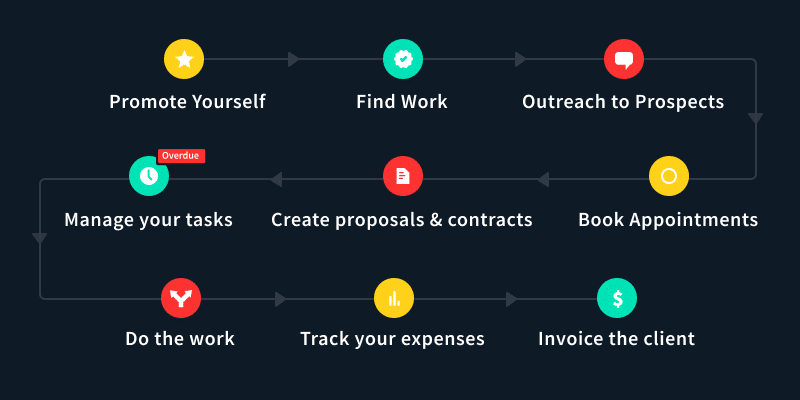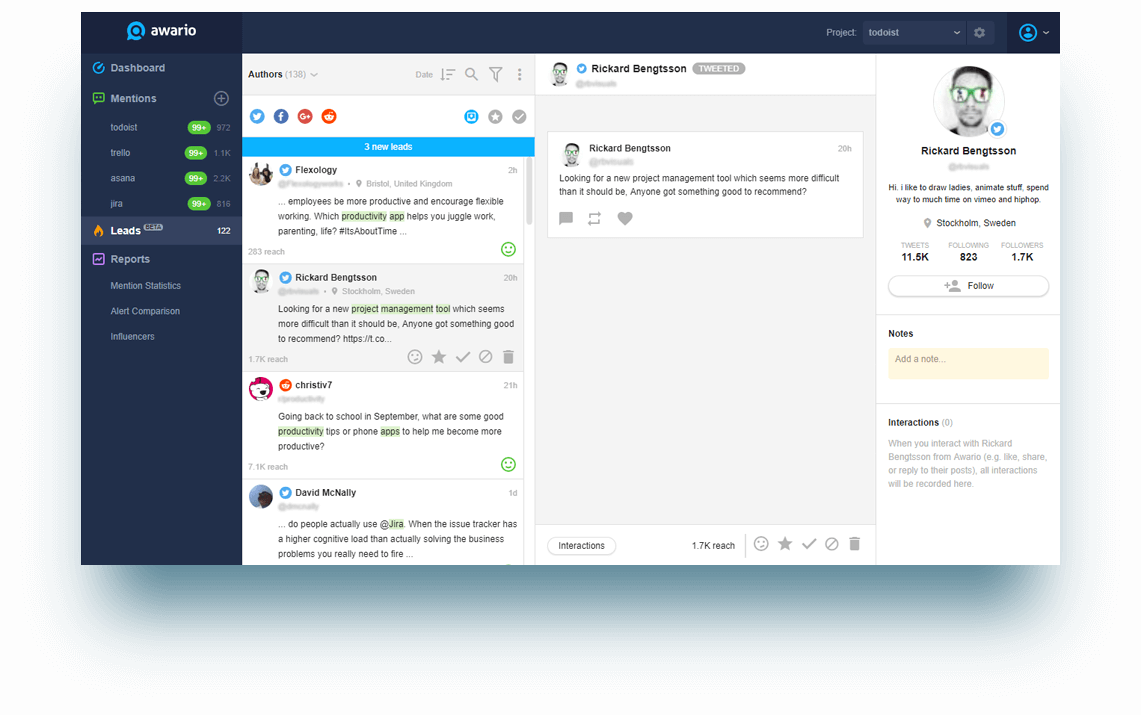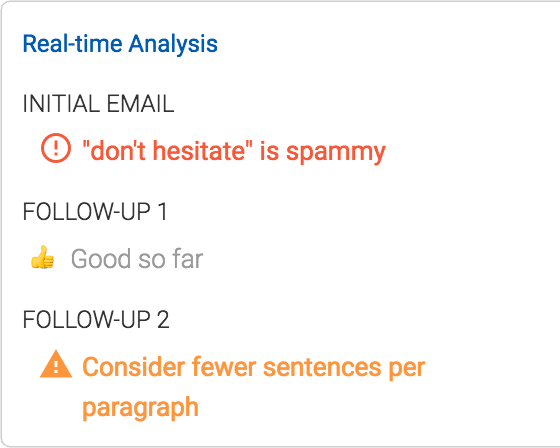5 Ways to Make Freelance Friends
If you ever feel a little lonely as a freelancer, you’re, uh, not alone…While your non-freelance friends are out celebrating a colleague’s birthday or sharing their
AND.CO is now Fiverr Workspace
We humans are pretty remarkable creatures. There’s almost nothing we can’t accomplish with ample drive and motivation.
But we have one major failing, one bottleneck that chokes our potential on a daily basis: we can only do one thing at a time.

Even the most powerful multitaskers among us aren’t exempt.
This can be bothersome for most people, but for freelancers it’s a major problem. You are your business. If something needs doing, it’s up to you to do it. You’re prioritizing a multitude of tasks on a daily basis.
More often than it should, the minutiae of running your business ends up drowning out the work that really matters: keeping your current clients satisfied, and growing your business.
Luckily, the market is beginning to understand that we’re on a path towards a 50% freelance workforce, and that these workers are hungry for the tools that’ll help them get stuff done.
Tons of tools have been designed to perform repetitive tasks far more efficiently than a human ever could.
So instead of trying to do everything yourself, you can automate many of the tasks required to make your business a success. Offload them onto digital “agents”, freeing you to concentrate on the tasks that truly require your expertise.
With the right tools, you could save yourself hours a week… Hours you can spend focusing on growing your business (or just getting more sleep—I’m not here to judge).
I’m about to break down how you can automate the entire cycle of a freelancing project, including:
Let’s get into it. (Or you can jump straight to a list of useful tools here.)

“Anytime you find yourself doing something multiple times, ask yourself, How can I do it just once and apply it to everything?”
– Paul Trani, Adobe
One of the most difficult steps in automating your business is determining which things you should do yourself and which you can let go of.
You first need to know yourself well enough to know which tasks you are best at, and which are slowing you down.
Content Marketing and SEO Consultant Bill Widmer suggests taking three courses of action:
“First, eliminate the tasks that are not making you money or that simply don’t need to be done. For example, perhaps you’ve been active on social media for months or years but no clients or revenue have come from it. Considering eliminating your social media presence.”
A simple way that I like to determine these tasks is to have a regular practice of reviewing which tasks I should stop, start, or keep doing. Data is extremely helpful for these reviews. Having an understanding of what percentage of time you spend on tasks versus how much impact they have for your business makes it really easy to stop working on tasks that may otherwise have felt difficult to let go of.
Second, automate anything that doesn’t need to be done by a human (more on how to do this in a moment).
Third, Widmer says you should “delegate anything that can’t be eliminated or automated. For example, if you need to create content, send/answer emails, or do any other task that needs to be done by a human but doesn’t need to be done by you, hire a VA to do this for you.”
Finally, if a task truly must be done by you, because it’s your area of expertise—the thing you specialize in that makes you very high dollar per hour income—then do that yourself.
The idea is to constantly review, question, and push the boundaries of what you need to do personally.
Let’s take a look at some of the things that can (and likely should) be automated in your business.

With everything else you have going on, you also have to find time to manage your social media presence. Wouldn’t it be great of there was a tool that held on to each and every post you made to all of the various platforms and then ‘rebroadcasted’ them for you at some point in the future when you have other things you need to do?
Of course it would be. And that’s what you get with MeetEdgar. The fact is you shouldn’t have time to post to social media every day, and even if you do, there’s a good chance a large portion of your audience won’t see what you post. MeetEdgar holds onto and categorizes your old posts and reposts them when you can’t, giving more people the chance to read the brilliant things you say and helping you post more often.
If you’re looking for a free solution, Buffer has a free version that will allow you to schedule a bunch of posts in one go, so you don’t have to constantly check back to social media (a distraction waiting to happen). You can even schedule it to post during your sleep so you can reach clients on all time zones.
Finding new clients is the lifeblood of a healthy, expanding freelance business. And while your attention is certainly necessary, you can offload some of the initial discovery tasks.
You can harness the power of Google’s search engine to help find new prospects. All you need to do is set up Google Alerts using prospecting keywords and then wait as the search giant scours the Internet looking for work for you. As an example, if you’re a writer you might set up an alert for “technical writing” and “hiring now”. Google will alert you via email whenever it finds an opportunity matching those criteria. Get creative. With the right alerts in place, you can turn Google into an opportunity-generating machine.
Cover all your bases and stay across job leads in the social space too with Awario.
 This tool can help you find clients who are looking for the services you offer via social media posts. Enter a description of your services and the algorithm will alert you when it discovers people who are looking for such services.
This tool can help you find clients who are looking for the services you offer via social media posts. Enter a description of your services and the algorithm will alert you when it discovers people who are looking for such services.If you’re a social media maven, posting high-quality material to multiple platforms on a regular basis, you’re likely to generate a bunch of direct messages from prospects. That’s great! But it can be distracting and time consuming having to answer these whenever they randomly pop up. Instead, you can utilize a chatbot to handle the initial discovery conversation, allowing you to get back to the vetted prospect when you have time.
Think of a chatbot as an artificial assistant that can carry on a simple conversation online, asking questions of your prospects and recording their answers. You can use it to qualify leads and get more information about them before you ever directly interact.
Aljaz Fajmut, the founder and CEO of Nightwatch says, “Through surveys and conversations, bots collect vital info on your clients so that they are then able to engage them in personalized, meaningful conversations that, over a series of micro-commitments, can increase client satisfaction and loyalty, conversions, and sales. The more helpful a chatbot is, and the faster it can respond to queries, the more loyal a client becomes towards a business.”
Some of the easiest chatbots to deploy come from Motion AI. These bots require no programming, and they have a simple visual interface that lets you set up rules of engagement so that you can quickly employ a chatbot and get it working for you the way you want.
If you’re using emails to reach out to the prospects that you find, automate your cold outreach with a tool like Mailshake. Rather than regularly rewriting your outreach emails, it can make the whole process quicker by providing pre-written templates or generating personalized templates for you after asking a few simple questions.

It also uses real-time analysis to suggest improvements on your emails and ways to not get marked as spam—making your outreach much more effective and saving you research time in the process. It can also automate follow up emails, which, according to Yesware, have a 21% chance of getting a reply if the first email goes unanswered.
At some point, we’ve all had to suffer through the annoying back and forth involved in trying to organize a meeting or group call. Getting everyone’s schedules synced can be a headache, particularly when you’re all in different places and time zones. And this is a basic task that definitely doesn’t deserve to take up your brilliant brainpower.
Instead, let your clients do the work, aided by a scheduling tool like Hubspot Meetings. Simply link it with your Google or Office 365 calendar, and then share your link with your invitees. They’ll be able to see when you’re available, based on rules you create, and choose a time to talk with you. All of your calendars are then automatically updated, without you ever having to be involved. And best of all, it’s free.
Bill Widmer also suggests automating your scheduling, “using Calendly and an API integration with your task software so you never have to manually schedule a client call again. You can integrate this for free with a tool like Zapier or IFTTT.”
Freelancers spend a lot of time creating proposals. We waste uncounted hours toiling away in clunky text editing or page layout programs trying to make it “just right”, fearing that one little mistake could cost us an important job. We input everything manually because we feel that’s the only way to guarantee a spotless final product.
Not anymore. There are tools designed specifically to take the drudgery out of crafting proposals, not only making them incredibly fast to create, but also ensuring human error doesn’t allow you to miss anything essential. (Incoming shameless plug): Fiverr Workspace’s custom proposal component lets you automate the whole process from proposal to payment.
Set up your custom branding once in the software to have it apply to every proposal. Easily include your own custom slides in each proposal. Automatically attach a contract to the proposal, allow the client to e-sign (because pens are so last decade), and automatically create a project in the software once the contract is signed. Collect payment deposits automatically at signing. Send automatic reminders to gently prompt your client to approve when the time comes. Configure your alerts to let you know when anything important happens, from the moment your prospect first reads the proposal to the moment they sign. You can even set the proposal to self-destruct after a set period of time if it’s not signed in time.
And of course your invoices can be automatically generated from your contracts, so you can take your entire project full circle; from proposal, to contract, to invoice, and payment, with as little involvement from you as possible.
We freelancers don’t have the luxury of being told what we should be working on when. We alone control the flow of our daily tasks. Without anyone there to motivate us to hit deadlines, task management becomes all the more important. Fiverr Workspace’s task management tool can help remind you of some of the important stuff that needs your attention but may be likely to fall through the cracks. It scrapes through your deadlines, projects, contract terms and other relevant inputs and magically generates tasks that need your attention. If it finds expenses that need filing, it tells you. If it finds invoices that need sending, it lets you know.
It’s like having your own personal assistant that never sleeps… Constantly, vigilantly watching over your business and alerting you to the things you need to get done. And it’s intelligent. It only alerts you to tasks when you truly need to act on them, but if you can’t at that moment, you can defer the task until later.
Business management tools can save you time on the more mundane tasks associated with running your businesses, but there are also plenty of tools that can help us when it comes time to sit down and get the actual projects done.
Adobe Libraries can help you automate updates across all versions. Link a logo to a Library and when it’s changed, it’ll update all files across the board. Save a bunch of time replicating elements by storing assets like graphics, colors, character and layer styles, and brushes. When you need them, you can access Libraries from whichever Creative Cloud app you’re in—like Illustrator, InDesign, Photoshop, After Effects, Premiere Pro, as well as mobile apps like Adobe Illustrator Draw and Adobe Photoshop Sketch.
Alex Birkett, Senior Growth Marketing Manager at Hubspot, says can save you a ton of time on boring stuff by using Wordable. “If you blog a lot, you might spend a significant amount of time uploading and reformatting your post in WordPress from your Google Doc. Wordable lets you do this automatically and in like ten seconds.”
Freelancer Inessa Bokhan says “When I worked as a freelance SEO (and I was a newbie too!), I spent lots of time on manual checks—rankings, keyword lists, backlinks, you name it, which wasn’t productive at the end of the day. Now my approach is – if something can be automated, it better be automated. With SEO PowerSuite’s toolkit and its built-in Scheduler option, all these routine tasks are managed automatically now, according to the schedule I’ve set for all my projects. It’s a huge time-saver and helps focus more on the main goals.”
Expense tracking is mind numbing and takes an inordinate amount of time to complete. And it’s never actually complete. This is absolutely a job you should automate. Imagine the amount of time you could get back for other purposes if this daily grind were taken off your shoulders.
Fiverr Workspace’s expense tracking feature makes short work of your expenses. Your credit card and bank account transactions can be automatically imported and categorized. Digital receipts can be forwarded directly to the app and paper receipts are entered with a simple snap of your mobile device’s camera.
You can filter all of your expenses by project or client, and keep on top of important trends using powerful yet simple custom stats and reports automatically generated from your expense data.
Best of all, you can instantly add expenses onto your client’s next invoice with the tick of a checkbox. And when they pay the invoice, any payment processing fees will be added directly as an expense. These slick integrations will save you a ton of time.
Invoicing in particular benefits from automation because collecting money from clients is difficult and, for some people, uncomfortable. If your invoices are cumbersome and time-consuming to create, you may find yourself sending them late or not at all.
Fiverr Workspace makes invoices smart. You can create invoices directly from your timesheets. Just track your time through the software and when it comes time for invoicing, you’ll see each of your tasks listed against your client or project. You have full control over how these invoices are displayed but—and this is important—you won’t have to lift a finger.
Invoices can be created automatically from your proposals and contracts. Literally pushing “send” is all you have to do.
Secure payments can be accepted using credit cards, ACH or PayPal right from the invoice. It even automates invoice follow up, with alerts showing you that your client has viewed the document, and reminders automatically generated when a payment is late.
I mentioned a bunch of tools that can help you automate your business.
Here they are again so you can quickly get started with them:
There’s a lot to process here, and it may seem overwhelming. But remember, the work you do to get set up now will save you orders of magnitude more work in the future.
And if you can’t even find the time to set up these time-saving tools, you can even hire a virtual assistant to set up them up you. I know a good place to find one… 😉
Our automated technology and intuitive tools take care of the small stuff so you can
focus on what matters